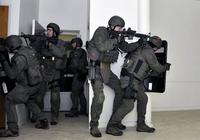-
TerrorismEuropol bolsters EU’s counterterrorism capabilities
Europe is currently facing the most significant terrorist threat in over ten years. The Paris attacks on 13 November 2015 indicate a shift toward a clear international dimension of Islamic State to carry out special forces-style attacks in the international environment. This and the growing number of foreign fighters are posing new challenges for EU Member States. Europol says that more attacks in the EU may happen in the future. Therefore, there is a great need within the European Union to strengthen our response to terror, to suspected terrorist networks and foreign fighters, and have an improved strategic understanding of threats.
-
-
ForensicsBullets database to help match bullets, cartridge cases to specific firearms
Researchers at the National Institute of Standards and Technology are working to improve ballistics matching methods with assistance from the Prince George’s County, Maryland, Police Department Crime Laboratory. Their work together will contribute to a collection of topographic data from thousands of fired bullets and cartridge cases. The collection, which they ultimately plan to issue as an open research database, will improve the scientific basis of forensic techniques used to match bullets and cartridge cases to specific firearms.
-
-
ConspiraciesDHS: conspiracy theories about DHS purchases unequivocally false

Conspiracy theorists have pointed to several DHS solicitations for gear and ammunition as “proof” that the department is in the process of creating, training, and equipping a secret force, the purpose of which would be to suppress public dissent – or worse: one blogger wrote that “Another possible conclusion [regarding DHS’s ammo purchases] is that the bullets are intended to coerce and, if need be, kill us.” DHS flatly rejects these conspiratorial assertions as unequivocally false, saying that each and every purchase is in line with past purchases and in support of on-going, legitimate, and transparent departmental operations.
-
-
ImmigrationCalifornia passes “Anti-Arizona” immigration measure

The California State Senate last Thursday passed Assembly Bill 1081 — some call it the Anti-Arizona law — under which local police officers would be limited to refer only those individuals convicted of serious felonies to immigration agencies; police officers would no longer have authority to detain lower-level offenders on their undocumented status
-
-
DisastersCrowd dynamics explains disaster at cultural, sports events
Physicists investigating a recent crowd disaster in Germany found that one of the key causes was that at some point the crowd dynamics turned turbulent, akin to behavior found in unstable fluid flows
-
-
Crime and punishmentBelief in hell associated with reduced crime
A broad study, study following143,197 people in sixty-seven countries over twenty-six years, found that criminal activity is higher in societies in which people’s religious beliefs contain a strong punitive component than in places where religious beliefs are more benevolent; a country where many more people believe in heaven than in hell is likely to have a much higher crime rate than one where these beliefs are about equal
-
-
Law-enforcement technologyIdentifying ammunition, gun used to commit a crime
New, Raman spectroscopy-based gun-shot residue (GSR) analysis technique would make it possible for forensic investigators to match minute amounts of GSR to the exact type of ammunition, and the caliber of the gun, used to commit a crime
-
-
Law-enforcement technologyTackling problem of roadside collisions between drivers, police vehicles
Police officers, when stopping a speeding car, would park their vehicle on the shoulder of the road, lights flashing, in order to talk with the errand driver; at least one police officer is killed each month in the United States when another driver, out of recklessness, impairment, fatigue, or simple inattention, careens into the stopped police car
-
-
Secure CommunitiesNo racial profiling, abuse by Secure Communities
The Earl Warren Institute at the University of California, Berkeley Law School claimed that DHS Secure Communities program suffers from a disturbing pattern of abuse of authority by ICE, including wrongful arrests of thousands of U.S. citizens, a pattern of racial profiling against Latinos, and denial of due process for aliens in removal proceedings; a new study by the Center for Immigration Studies says this is not the case
-
-
Domestic terrorismFBI increasingly concerned with “sovereign citizen” movement

Over the past decade, the FBI has grown increasingly concerned with the “sovereign citizen” movement; since 2000, sovereign citizens have killed six police officers and violent battles with law enforcement agents are on the rise; the U.S. National Counterterrorism Center classified the movement as a major threat alongside Islamic extremism
-
-
HackersAnonymous retaliates, takes down Interpol site

In retaliation for the arrest of twenty-five suspected members of the hacktivist collective known as Anonymous, the group briefly took down Interpol’s website on Tuesday
-
-
SurveillanceSurveillance truck helps Fort Lauderdale keep streets safe
Police in Fort Lauderdale, Florida are trying a new approach to fighting crime – blatantly telling criminals they are under surveillance
-
-
Facility securitySmithsonian balances security and openness – is it safe?

Following the 9/11 attacks security officials worried that the Smithsonian Institution with its millions of visitors and stores of valuable national treasures would be an ideal target for terrorists, yet the institution has done little to bolster security
-
-
Football securityNFL implements enhanced security procedures, fans grumble
Football fans across the country are now being subjected to additional security measures before they are allowed to enter a stadium to watch their team play
-
-
Prison cyber-vulnerabilityPrison systems vulnerable to cyberattack

At the recent Hackers Halted convention in Miami, researchers John J. Strauchs and his daughter Tiffany Strauchs Rad told the audience how with only $2,500 and some basic equipment, they were able to develop a cyberattack on a simulated prison computer system with potentially catastrophic results
-
- All
- Regional
- Water
- Biometrics
- Borders/Immig
- Business
- Cybersecurity
- Detection
- Disasters
- Government
- Infrastructure
- International
- Public health
- Public Safety
- Communication interoperabillity
- Emergency services
- Emergency medical services
- Fire
- First response
- IEDs
- Law Enforcement
- Law Enforcement Technology
- Military technology
- Nonlethal weapons
- Nuclear weapons
- Personal protection equipment
- Police
- Notification /alert systems
- Situational awareness
- Weapons systems
- Sci-Tech
- Sector Reports
- Surveillance
- Transportation
Advertising & Marketing: advertise@newswirepubs.com
Editorial: editor@newswirepubs.com
General: info@newswirepubs.com
2010-2011 © News Wire Publications, LLC News Wire Publications, LLC
220 Old Country Road | Suite 200 | Mineola | New York | 11501
Permissions and Policies
Editorial: editor@newswirepubs.com
General: info@newswirepubs.com
2010-2011 © News Wire Publications, LLC News Wire Publications, LLC
220 Old Country Road | Suite 200 | Mineola | New York | 11501
Permissions and Policies
